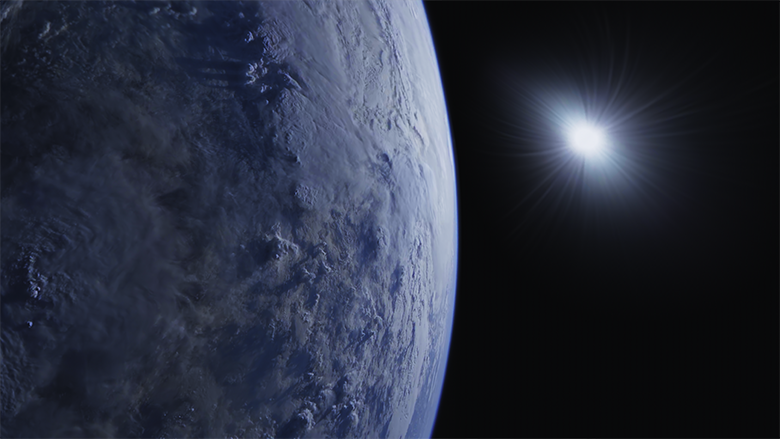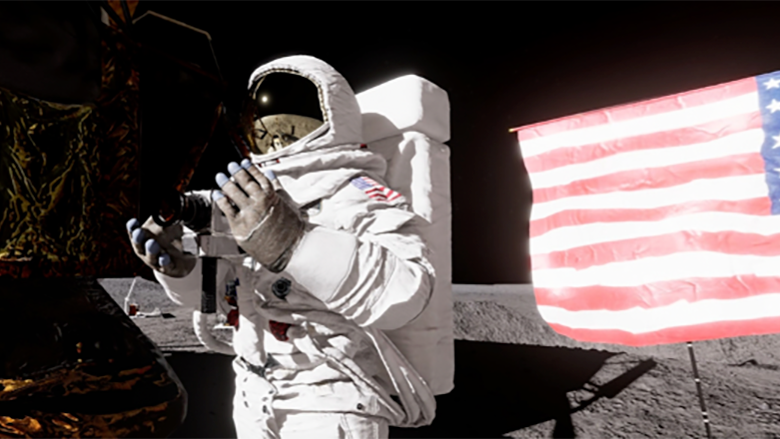Greetings, Earthlings! It’s National Moon Day, so we’re celebrating with the release of EXPAND—the latest installment of Space Explorers. The groundbreaking series from Felix & Paul Studios is available to watch for free on Oculus TV for the Meta Quest Platform and on the Space Explorers app on the Quest store.
In 2017, speaking at Connect and introducing Felix & Paul’s Space Explorers, Meta CEO Mark Zuckerberg hit on one of the primary motivations for the series—the fact that VR makes it possible to capture and share high-quality imagery from anywhere, even space: “Most of us will never get to experience zero gravity or travel to the space station,” Zuckerberg said, “but you can in VR.”
Over the last few years, Felix & Paul Studios has installed two NASA-approved 360-degree cameras on the International Space Station, which have already generated more than 400 hours of content. Soon, NASA will be launching its Artemis program, which will send the first woman and person of color to the moon. And as part of that effort, Felix & Paul will host a livestream of the launch of Artemis I, an unmanned rocket that will perform a lunar flyby later this year. You can catch the action in Venues in Horizon Worlds on Meta Quest 2.
To talk about these issues and how an exploration of space is one of the most inspirational things a human can do, we spoke with Felix & Paul Studios Co-Founder and Creative Director Paul Raphaël.
VR is such a great tool for “democratizing” access. How has that informed your studio, and what made you decide to focus your creative efforts on space?
Paul Raphaël: We’ve been using the unmatched power of VR to bring audiences to hard- or impossible-to-experience places and encounters, both real and fictitious, for close to a decade.
Taking audiences to space has been a dream of ours since the inception of our studio. And so, while nothing can truly replace actually going somewhere—like space—VR is able to give people that sense of being there, more than any other medium. That’s a profoundly powerful thing.
We’re in a new era of public-private collaboration in the space sector, and it has truly given the industry a shot in the arm. There’s the promise of a return to the moon to create a sustained presence there, as well as of expanding our horizons by sending humans to Mars and of seeing farther and more clearly into space and time through the James Webb Space Telescope. Together, all this and more has reinvigorated the public’s interest in the possibilities of space travel and sparked our collective imagination of the possibilities of things to come.
What are some of the biggest challenges you’ve had to overcome to give people compelling VR space experiences?
PR: We’ve been working on this for more than half a decade, and it has involved entering unfamiliar territory, literally—from developing relationships with NASA, the Canadian Space Agency, and several other actors in the private and public space sector to learning the protocols and methodologies inherent in such projects. Plus, we had to design and send a camera out into the vacuum of space, which was by far our studio’s most ambitious undertaking. None of this would have been possible without the collaboration of hundreds of contributors.
What’s been your favorite thing about working on space-related projects?
PR: The moment we successfully transmitted our first live feed from outside the International Space Station, which hovers more than 250 miles above the Earth, was something I and the rest of our team will never forget. Tears were shed, and of course, hugs would’ve been shared if it wasn’t for social distancing.
How will VR be used to immerse people in real time into future space missions, such as Artemis I or even going to the moon?
PR: We’re actively documenting humanity’s return to the moon, starting with the preparations of the Artemis mission, and we plan on being there when the spacecraft touches down on the moon.
If there’s one thing you’d like your audience to take away from the experience of space you give them, what would it be?
PR: There are few experiences that are as reliably transformative as observing our home planet in its entirety in a single glance. Only a handful of humans have ever had this opportunity. So we want to give many more people the chance to witness the beauty of our immeasurably precious home and to realize its fragility.

What does our fascination with space say about us?
PR: I think space holds the answers to many of the fundamental questions humans have been asking themselves since the dawn of consciousness. Where do we come from? What is the nature of our reality? Are we alone in the universe? These larger questions and the international collaboration needed to accomplish these endeavors are also strongly unifying forces which, in this day and age especially, can be truly inspirational.
Great VR Content That Can Take You Into Space Today
Ready to celebrate National Moon Day from home? Grab your Meta Quest and try out some of the many great space-related experiences available today.
Space Explorers: The ISS Experience
The largest production ever filmed in space, Space Explorers: The ISS Experience is an epic four-part immersive series that invites you to join eight astronauts on life-changing missions aboard the International Space Station. Shot over two years with exclusive access to the crew, The ISS Experience offers an intimate take on the joy, wonder, and dangers of life in orbit.
On July 21, 1969, Neil Armstrong captured the most iconic image of the 20th century. That image was taken with a custom Hasselblad EL500 as Buzz Aldrin was in motion traversing towards the lunar module. In fact that same camera still lies on the surface of the moon (sans film of course) with several other cameras, EL7 life support backpacks, and other things that were not needed and only provided extra weight that made it more difficult to lift off from the moon.

When We Were Apollo is an intimate and personal look at the Apollo Space Program through the lives and experiences of some of its most inspiring behind-the-scenes figures: engineers, technicians, builders, and contractors who spent the better part of a decade working to get us to the moon and back. Half a century later, the Apollo Space Program remains the single greatest initiative in peacetime the world has ever known. Behind every astronaut who set foot on the moon and every figurehead who inspired us to get there was Apollo’s massive workforce: a team of men and women over 400,000 strong spanning race, socio-economics, culture, company, and country who came to understand that the overall Program was only as good as the effort they put into it. With incredible access and interviews with members of the original Apollo effort, we explore the single greatest united collaboration and the real people behind the most inspirational success story in human history.
Apollo Astronauts: Training NASA’s Moon Men
In 1969, Neil Armstrong stepped onto the lunar surface and into the history books as the first of only 12 men to walk on the Moon. But in 1961 when Kennedy pledged to put a man on the Moon, NASA had barely put a man into orbit. They had less than 10 years to train a team of astronauts to overcome the unknown challenges of a mission to the Moon. Featuring stunning NASA footage and expert interviews with Apollo space scientists, this inspirational film explores the early days of astronaut training, following those pioneering pilots from selection to the lunar surface and back again. This is the incredible story of how NASA trained America’s best pilots to fly to the Moon and take one giant leap for Mankind.
This series of short films from Space Explorers details life aboard the International Space Station.
- AR/VR
- blockchain
- blockchain conference ar
- blockchain conference vr
- coingenius
- crypto conference ar
- crypto conference vr
- extended reality
- Metaverse
- mixed reality
- Oculus
- oculus games
- oppo
- plato
- plato ai
- Plato Data Intelligence
- PlatoData
- platogaming
- robot learning
- telemedicine
- telemedicine companies
- Virtual reality
- virtual reality game
- virtual reality games
- vr
- zephyrnet











